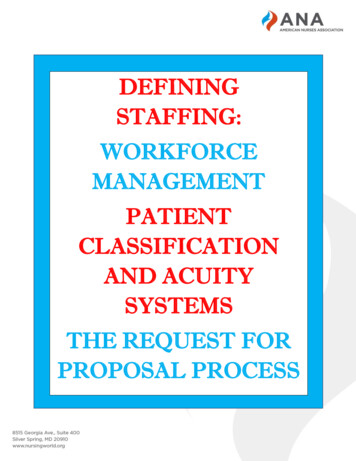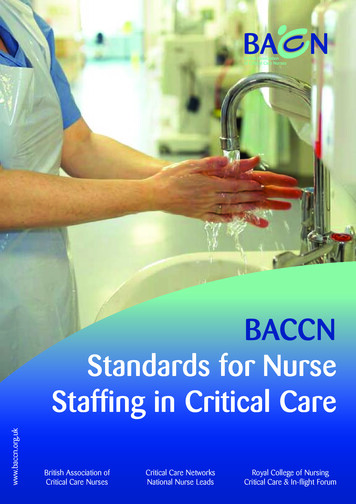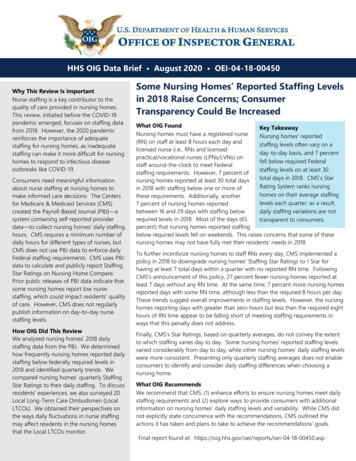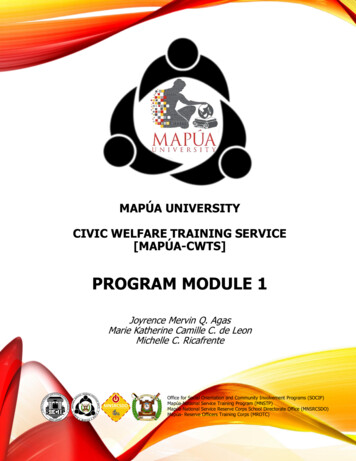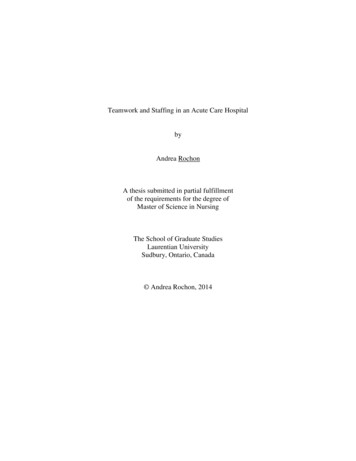
Transcription
Teamwork and Staffing in an Acute Care HospitalbyAndrea RochonA thesis submitted in partial fulfillmentof the requirements for the degree ofMaster of Science in NursingThe School of Graduate StudiesLaurentian UniversitySudbury, Ontario, Canada Andrea Rochon, 2014
iiTHESIS DEFENCE COMMITTEE/COMITÉ DE SOUTENANCE DE THÈSELaurentian Université/Université LaurentienneSchool of Graduate Studies/École des études supérieuresTitle of ThesisTitre de la thèseTEAMWORK AND STAFFING IN AN ACUTE CARE HOSPITALName of CandidateNom du candidatRochon, Andrea M.DegreeDiplômeMaster of ScienceDepartment/ProgramDépartement/Programme NursingDate of DefenceDate de la soutenance June 26, 2014APPROVED/APPROUVÉThesis Examiners/Examinateurs de thèse:Dr. Roberta Heale(Supervisor/Directrice de thèse)Dr. Michele Parent(Committee member/Membre du comité)Dr. Elena Hunt(Committee member/Membre du comité)Dr. Joan Almost(External Examiner/Examinatrice externe)Approved for the School of Graduate StudiesApprouvé pour l’École des études supérieuresDr. David LesbarrèresM. David LesbarrèresDirector, School of Graduate StudiesDirecteur, École des études supérieuresACCESSIBILITY CLAUSE AND PERMISSION TO USEI, Andrea M. Rochon, hereby grant to Laurentian University and/or its agents the non-exclusive licenseto archive and make accessible my thesis, dissertation, or project report in whole or in part in all forms ofmedia, now or for the duration of my copyright ownership. I retain all other ownership rights to thecopyright of the thesis, dissertation or project report. I also reserve the right to use in future works (suchas articles or books) all or part of this thesis, dissertation, or project report. I further agree that permissionfor copying of this thesis in any manner, in whole or in part, for scholarly purposes may be granted by theprofessor or professors who supervised my thesis work or, in their absence, by the Head of theDepartment in which my thesis work was done. It is understood that any copying or publication or use ofthis thesis or parts thereof for financial gain shall not be allowed without my written permission. It is alsounderstood that this copy is being made available in this form by the authority of the copyright ownersolely for the purpose of private study and research and may not be copied or reproduced except aspermitted by the copyright laws without written authority from the copyright owner.
iiiAbstractThe literature suggests that teamwork among patient care teams can have positive effects onwork environment, job satisfaction, and quality of patient care. The purpose of this study was todetermine the perceived level of nursing teamwork by registered nurses, registered practicalnurses, personal support workers, and unit clerks working on patient care teams in one acutetertiary care hospital in northern Ontario, and to determine if there is a relationships between thestaff scores on the Nursing Teamwork Survey (NTS) and participant perception of adequatestaffing. Using a quantitative descriptive cross-sectional research design, 600 staff were invitedto complete the NTS with a 33% response rate (N 200). The participants from the critical careunit reported the highest scores on the NTS, while participants from the inpatient surgical (IPS)unit reported the lowest scores. Participants from the IPS unit also reported less experience, lesssatisfaction in their current position, and a higher intention to leave. No statistically significantcorrelation was found between scores on the NTS and the perception of adequate staffing.Strategies to increase teamwork among patient care teams may positively influence jobsatisfaction and patient care on patient care units.Keywords: team, teamwork, staffing, nursing, patient care
ivAcknowledgementsI would like to extend my sincerest gratitude to my supervisor, Dr. Roberta Heale for herpatience, guidance, and mentorship throughout the development of this thesis. Thank you forbelieving in me and providing me the encouragement I needed to overcome some of thechallenges I faced in completing this thesis. I would also like to acknowledge my committeemembers Dr. Michele Parent and Dr. Elena Hunt who were always willing to provide me withfeedback, suggestions, and positive comments. I truly appreciate your willingness to share yourknowledge and experience with me.Thank you to the staff at the North Bay Regional Health Centre for taking the time tocomplete the Nursing Teamwork Survey. Your willingness to share your opinions andperceptions was invaluable to this study.Thank you to Dr. Beatrice Kalisch who graciously agreed to allow me to use the NursingTeamwork Survey for this research.I would also like to thank my family for supporting me during this journey. To myparents, who have always been there for me, and provided me with endless opportunities, you arethe reason I am where I am today. To my sister, who is always there for me, willing to listen oroffer words of encouragement. To my loving husband who has done everything he could toensure I was able to complete this thesis, thank you for providing me with the motivation Ineeded to accomplish this goal. I love you all so much and I am so grateful to have such anincredible family, this thesis is dedicated to all of you.
vTable of ContentsTitle PageiThesis Defense CommitteeiiAbstractiiiAcknowledgementsivChapter IIntroduction1Background1Nursing and Teamwork2Teamwork and Staffing7Problem Statement8Statement of Purpose of the Study8Research Questions9Significance to Nursing9Conceptual Framework10Chapter IILiterature Review11Definition of Team and Teamwork17Team.17Teamwork.18Barriers and Facilitators to Teamwork within Patient Care Teams19Conceptual Definitions21The “Big Five” Framework of Teamwork21
viTeam Leadership.23Mutual Performance Monitoring.24Backup Behaviour.24Adaptability.25Team Orientation.25Shared Mental Models.25Closed-Loop Communication.26Mutual Trust.26Adequate Staffing27Teamwork and Staffing28Chapter IIIStatement of Purpose of the Study30Research Questions30Research Design30Setting30Sample31Inclusion and Exclusion od38Data Collection.38Data Management.39
viiData Entry and Cleaning.40Analysis40Power Analysis41Reliability41Demographics/Participant Information41Research Question #147Research Question #253Chapter IVResultsChapter VDiscussion54Demographic Characteristics.54Research Question #1.58Research Question #2.62Strategies for Improving Teamwork.65Summary.66Limitations67Future Considerations67Recommendations for Future Research.67Recommendations for Practice.70Conclusion73
viiiList of TablesTable 1. Usual work unitTable 2. AgeTable 3. Education levelTable 4. Highest degree for nursing staffTable 5. Job title/roleTable 6. Experience working in current role and on current unitTable 7. Usual shiftTable 8. Missed work (due to illness, injury, extra rest)Table 9. Intent to leave current positionTable 10. Frequency unit is adequately staffedTable 11. NTS score by patient care unitTable 12. NTS Subscale ScoresTable 13. Comparison of mean subscale scores from the NTS for each patient care unitTable 14. Percentage of participants in each age category and patient care unitTable 15. Comparison of experience in role between inpatient surgery and all other unitsTable 16. Satisfaction with level of teamwork on unitTable 17. Perception of staffing adequacy for all participants
ixList of AppendicesAppendix A: Original Email InvitationAppendix B: Nursing Teamwork SurveyAppendix C: Reminder Invitation Email
1Chapter IBackgroundTeamwork is currently a topic of interest in healthcare. There is an expectation that thevarious healthcare disciplines will work together to ensure that all patients and families arereceiving optimal care in any health care setting (Estryn-Behar et al., 2007). The nursingprofession tends to focus on teamwork that seeks to ensure safety and satisfaction for both thepatient and staff populations (Nelsey & Brownie, 2012). Teamwork is thought to benefitmembers of the patient care team in a number of ways (Rafferty, Ball, & Aiken, 2001), andeffective teamwork has been suggested as a means of overcoming some of the challenges facedby patient care teams (Nelsey & Brownie, 2012). Effective teamwork promotes a workenvironment that has a positive impact on both staff and patients (Kalisch & Lee, 2009; Rathert& Fleming, 2008).In a continuously changing work environment, teamwork can be helpful in ensuring thatpatient safety is maintained despite ongoing changes in patient condition and workload (Kalisch& Lee, 2010). However, effective teamwork does not necessarily occur amongst a group ofpeople simply because they are called a “team” or are expected to work towards a common goal,which is the case of healthcare teams should be safe, quality patient care (Kalisch, Weaver, &Salas, 2009). Unfortunately, there may be many situations or circumstances where individualsare working in silos instead of engaging in effective teamwork (Kalisch & Lee, 2010; Leonard,Graham, & Bonacum, 2004).
2Nursing and TeamworkThe nursing profession tends to focus on teamwork that seeks to ensure safety andsatisfaction for both the patient and staff populations (Nelsey & Brownie, 2012). The currentpatient population is one that is aging, is more acutely ill, and has higher rates of chronic illness.This leaves nurses with a heavier workload and less than ideal work environments (Nelsey &Brownie, 2012), which may impact their participation in effective teamwork on health careteams.It has been well-documented in the nursing literature that teamwork is an effective meansof improving quality in a workplace, job satisfaction among health care workers (Kalisch &Begeny, 2005), and quality of patient care (Miller, et al., 2008; Purdy, Laschinger, Finegan,Kerr, & Olivera, 2010). Furthermore, patient safety is enhanced by effective nursing teamwork(Kalisch, Weaver, & Salas, 2009). Rafferty, Ball, and Aiken (2001) found that teamwork wasalso associated with greater staff retention and less job stress and burnout. Thus, teamwork mayprovide many benefits to both the staff members working on a patient care unit and the patientsunder their care.Teamwork may help with changing individual ideas of patient care from “my” patientassignment to “our” patient assignment, thus increasing the accountability of the entire teamcaring for a particular patient population on a patient care unit. In a continuously changing workenvironment, teamwork can be helpful in ensuring that patient safety is maintained despiteongoing changes in patient condition and workload (Kalisch & Lee, 2010). In comparison withother healthcare disciplines, nurses tend to report lower levels of teamwork (Chang, Ma, Chiu,Lin & Lee, 2009). Kalisch, Russell and Lee (2013) suggest that developing a furtherunderstanding of the teamwork among the consistent patient care team will ultimately result in
3enhanced teamwork among the multidisciplinary team. This idea is supported by the researchconducted by Kalisch, Lee, & Salas (2010).Teamwork can help health care workers to achieve the ultimate goal of providing safe,efficient, and quality care to patients. Health care providers working together effectively as ateam tend to make less errors than those working independently (Clark, 2009; Kalisch & Lee,2009). When staff members perceive a more positive work climate, including teamwork, theyalso tend to perceive enhanced patient outcomes (Hinno, Partanen & Vehvilainen-Julkunen,2011). Purdy et al. (2010) propose that teamwork is one of the main processes used inaccomplishing safe and effective patient care, and this should undoubtedly be one of the prioritygoals for patient care teams. Pringle & Doran (2003) (as cited in Purdy et al., 2010) providedexamples of quality patient outcomes: patient satisfaction and patient ability to participate inactivities of daily living. However, Purdy et al. (2010) also identified that previous research hasoften focused on how nurses perceive quality of patient care without focusing on how patientsand families perceive and understand this concept or on specific measures such as incidence oferrors or accidents. In their concept analysis, Xyrichis and Ream (2008) found quality patientcare to be one of the consequences of teamwork. It was suggested by Simpson (2009) that thequality of care provided to patient populations is positively influenced by how the nurses work toaccomplish that goal.Teamwork can have a positive influence on how employees view the quality of theirwork environment. As one of the many work environment factors, teamwork can impact howone perceives some of the related factors such as leadership and staffing, and subsequently howthey experience the patient care team (Hinno et al., 2011). When effective teamwork is
4occurring, it may provide reassurance to individual team members that they are supported by ateam (Simpson, 2009), which may promote satisfaction in their role and work environment.There is some research suggesting that effective teamwork can enhance job satisfactionfor employees (Xyrichis & Ream, 2008). Kalisch, Lee and Rochman (2010) found that not onlythe level of teamwork, but also the type of patient care unit, to be factors contributing to jobsatisfaction, with staff working on specific patient care units more likely to identify themselvesas being satisfied with their current position. A correlation also exists between the level of jobsatisfaction and an employee’s intention to leave their position (Larrabee et al., 2003).According to Estryn-Behar et al. (2007), teamwork may be a factor that will deter team membersfrom leaving their position, because of the positive influence it has on the work environment.There was also research conducted that suggested teamwork contributes to recruitmentand retention of staff (Nelsey & Brownie, 2012). The recruitment and retention of skilled,educated staff is a challenge currently facing the nursing profession (Nelsey & Brownie, 2012).Retention can be promoted by ensuring that work environments are conducive to job satisfactionof individual staff members, as well as the team as a whole (Nelsey & Brownie, 2012).Retention of trained, qualified staff is one of the many benefits that effective teamwork mayprovide to the organization as a whole (Xyrichis & Ream, 2008).Job burnout in the nursing profession is one of many factors contributing to nursesleaving their positions (Estryn-Behar et al., 2007). Teamwork may decrease the levels of stressand burnout among team members. This may be because when effective teamwork is occurring,team members may experience fewer feelings of stress and may subsequently experience lessburnout.
5Conversely, a lack of effective teamwork may result in consequences such as a decreasein productivity and the inability to complete work in a timely and efficient manner (Salas, Sims,& Burke, 2005). Therefore, the importance of teamwork on any team should not beunderestimated.Recently, research has focused on multidisciplinary or interprofessional teamwork, whileteamwork among the consistent staff (registered nurses, registered practical nurses, personalsupport workers, and unit clerks) on a patient care unit has not received as much attention. Thestaff working in these specific roles are those that tend to be on one particular patient care unitmore often and providing direct care to the patients on the unit (Kalisch, Weaver, & Salas, 2009).In particular, acute care medical-surgical units have received little attention in the existingresearch about teamwork in comparison with specialty areas like the emergency room (ER),operating room (OR), and intensive or critical care units (ICU/CCU). According to the CanadianInstitute for Health Information (CIHI) (2010), in 2008, 17.2% of frontline nursing staff, inCanada, worked in a medical-surgical setting, the largest percentage of any clinical area; whileSpratley et al. estimate the number of nurses in these clinical settings to be as high as 32% in theUnited States (as cited in Davis, Ward, Woodall, Shultz & Davis, 2007). With greater than44,000 RNs in these settings, it is clear that research to help enhance team functioning wouldbenefit both staff and patients, by identifying current issues and providing suggestions forimprovement (CIHI, 2010). In a study by Kalisch and Lee (2009), it was found that nursingteams working on medical-surgical units often reported lower levels of teamwork than in otherclinical areas. As well, Schmalenberg and Kramer (2008) found that nurses who work in acutemedical-surgical nursing settings often perceived their work environment to be less productive
6than those in other areas, with inadequate staffing identified as being one of the manycontributing factors.In a changing healthcare arena, with issues such as an aging population (Purdy et al.,2010) and an increase in chronic disease, patient care teams will be faced with a number ofchallenges that will require them to use the available human resources to continue to providequality patient care. The nursing profession is facing a number of workforce issues includingstaff shortages and high turnover rates (Kalisch et al., 2010a). These issues are compounded bythe fact that the Canadian Nurses Association (2009b) projected there may be a shortage of closeto 60,000 RNs in Canada by 2022 if nothing is done to alleviate the situation. In 2001, Aiken etal. provided a number of issues that may go along with an ongoing shortage of hospital nursesincluding an increase in nurses who experience a lower level of job satisfaction, an increase innurses contemplating leaving their current position, a workforce increasing in age, and young ornewly graduated nurses seeking employment in agencies other than acute care hospitals. Due tobudget and financial constraints, hospitals and other health care facilities are not necessarily in aposition to hire additional staff. It is clear that changes must occur, and strategies implemented,to ensure that nurses currently in the workforce are used to their optimal capacity in order topromote work satisfaction, patient and staff safety, and to facilitate the best possible patienthealth outcomes.
7Teamwork and StaffingThe staffing issues that the nursing profession is facing may have serious implications forthe future of patient care. The Canadian Nurses Association (2009b) suggested that makingimprovements to work environments in order to increase staff productivity might be one optionto offset some of the burden from inadequate nursing staff across the country. Teamwork is onemechanism that may enhance the productivity of a nursing team (Salas, Sims, & Burke, 2005), aswell as enhance the level of job satisfaction (Kalisch et al., 2010a). When nurses perceive poorteamwork, they may be more inclined to leave their position (Estryn-Behar et al., 2007). Thismay lead to staffing problems such as recruitment, retention, and turnover.Staffing levels have been cited in the nursing research as a factor associated withteamwork (Kalisch & Lee, 2011). The concept of nurse-to-patient staffing ratio is one approachused in the staffing research which focuses on developing a better understanding of therelationship between the actual number of nurses to the number of patients assigned on aparticular shift (Unruh, 2008). Staffing skill mix can also be addressed by looking at theeducation or experience level of each staff member when considering staffing levels andappropriate patient assignments (Unruh, 2008). Determining what constitutes adequacy in termsof staffing may vary significantly between units depending on multiple factors (Unruh, 2008).For this reason, adequate staffing may be subjective and based on individual perceptions, inaddition to what each individual is comfortable with in terms of workload and nurse-to-patientratio. For example, some staff may feel that they are capable of handling a larger and more acutepatient load than others, while other staff members may feel overwhelmed with the usual patientassignment on that unit. Furthermore, nurse perceptions may depend on the acuity andcomplexity of patients, and the education and experience of each staff member.
8It is evident that nursing and health care will continue to face hardships in terms ofhuman resources in the future. It will likely take multiple strategies and interventions to alleviatesome of the burden that inadequate staffing will have on patient care. The benefits of teamworkfor both patients and staff are numerous. Teamwork among patient care teams, bothintradisciplinary and interdisciplinary, may help to ensure that all patients receive safe, quality,consistent care; while health care providers experience a positive work environment, increasedjob satisfaction, and decreased stress and burnout.Problem StatementWhile the benefits of nursing teamwork have been clearly demonstrated in the literature,effective teamwork is not always achieved on patient care units in a hospital setting (Kalisch,Weaver, & Salas, 2009). There is also a link between having a full staff complement, oradequate staffing for the unit, and the level of nursing teamwork that occurs within a patient careteam during a particular shift.Kalisch and Lee (2009) suggested that staff working on medical-surgical units tend toperceive a lower level of teamwork than staff working on other patient care units. However,little research has been conducted in these clinical areas, including surgical units. All hospitalunits could benefit by having more effective and efficient patient care teams.Statement of Purpose of the StudyThe purpose of this study is to determine the perceived level of (nursing) teamwork byindividuals working on patient care teams, in an acute-care healthcare facility. The study willalso seek to determine if there is a relationship between the perception of the level of staffing andthe level of nursing teamwork on each patient care unit. The results of the study will seek to
9guide discussion about strategies that may be implemented to enhance effective teamwork onpatient care units.Research Questions1. What is the level of nursing teamwork on each patient care unit of a hospital?2. Does a relationship exist between the perception of the level of staffing and the levelof nursing teamwork, on each patient care unit?Significance to NursingTeamwork is an important current issue in nursing. There is focus in the research oninterdisciplinary and interprofessional teams, but a lack of literature addressing teams on apatient care unit (Kalisch & Lee, 2010; Kalisch, Weaver, & Salas, 2009). Furthermore, themajority of research conducted about teamwork in nursing has involved the specialty clinicalsettings such as the ER and OR (Kalisch & Lee, 2010). Nurses (both registered nurses andregistered practical nurses), personal support workers, and unit clerks are the most consistentstaff members working on a patient care unit in the sense that they often have a “home” unitwhere they spend the majority of their time working. Furthermore, these staff members arealmost always present on the unit, while allied health professionals tend to work weekdays morefrequently. Therefore, it is essential that the consistent staff members are able to functioneffectively as a team (Kalisch, Weaver, & Salas, 2009).Work environments often include high levels of stress, acuity of patients, and potentialfor errors. Nurses and members of the patient care team must consider adopting strategies toenhance job satisfaction and quality of patient care (Salas, Rosen, & King, 2007). In order toensure patient safety, positive patient outcomes, job satisfaction, and staff retention, it isimportant to develop a better understanding of work environment factors and characteristics,
10such as teamwork, and the implications of these for practice. For these reasons, teamworkamong patient care teams must be further investigated (Kalisch, Russell, & Lee, 2013).Conceptual FrameworkThe conceptual framework used to guide this research was the “Big Five” in teamwork(Salas, Sims, & Burke, 2005). This model was also used in the development of the NursingTeamwork Survey (Kalisch, Lee & Salas, 2010b), the instrument used to measure the twovariables of interest in the current study. The framework includes five “core components” andthree “coordinating mechanisms”. The five primary components are: team leadership, mutualperformance monitoring, backup behaviour, adaptability, and team orientation. The threeadditional components are: shared mental models, mutual trust, and closed-loop communication(Salas, Sims, & Burke, 2005). Each of these concepts will be discussed in the following section.
11Chapter IILiterature ReviewA literature review was conducted in order to determine what research existed aboutteamwork among patient care teams and staffing in nursing. The literature review included asearch of multiple databases: CINAHL, Proquest, and OVID. The keywords utilized in thesearch engines were: teamwork, nursing, staffing, adequate staffing, and perception of staffing,work environment, and nursing teams.The literature search revealed relatively few articles pertaining specifically to teamworkon nursing and patient care teams on inpatient units, while specialty clinical areas such as theoperating room, intensive care unit, and emergency room have received significant attention inthe research. One concept analysis about teamwork was retrieved (Xyrichis & Ream, 2008).Some potentially appropriate articles were excluded due to being published in a language otherthan English. As well, much of the recent research about teamwork in health care focused oninterdisciplinary teams as opposed to strictly patient care (nursing) teams (Kalisch & Lee, 2009).The majority of the recent research about nursing teamwork and the functioning ofnursing teams has been conducted by one group of researchers. Most of their published workincluded participants with a similar demographic to the targeted population in the current study.A review of the reference lists provided in key articles was also completed to ensure a thoroughsearch of available and relevant literature.Kalisch and Lee (2009) surveyed 1,758 members of patient care teams from two hospitalsusing the NTS. The results revealed that the medical-surgical units had some of the lowestscores for teamwork overall, while the maternal-child units had some of the highest scores. Theresults also showed a correlation between experience on the unit and overall scores on the NTS,
12whereby participants with less than six months experience on their patient care unit had higherscores; this was an indication staff perceived higher levels of teamwork occurring on their patientcare unit. The researchers also found that participants who perceived their unit was adequatelystaffed 100% of the time scored highest on the NTS (Kalisch, & Lee, 2009).In a larger study where 3675 participants completed the NTS, the majority of staff were35 years or older (62.3%), and over half had a baccalaureate nursing degree (55.7%) (Kalisch,Lee, & Rochman, 2010). In this study, most staff held full-time positions (83.8%). This studyfocused on the level of job satisfaction, as measured by the NTS. Participants who had higherscores on the NTS tended to be more satisfied with both their current position and occupation(Kalisch, et al., 2010a). According to the results of this study, the participants who perceivedadequate staffing on their work unit also tended to rate their satisfaction in their role higher(Kalisch et al., 2010a). Participants who worked in the emergency department were moresatisfied in their positions in comparison to those working on a medical-surgical unit (Kalisch etal., 2010a).A study of 2545 participants examined the relationship between staffing levels and scoreson the NTS (Kalisch & Lee, 2011). Participants with higher scores on the NTS perceived higherlevels of teamwork on their patient care unit, while those with lower scores on the NTSperceived lower levels of nursing teamwork on their unit. This study used hours per patient dayas a variable to determine staffing on each unit. The study suggested that adequate staffing wasan essential factor for teamwork to occur on patient care units. The results showed that a higherlevel of staffing, as measured by the hours per patient day, lead to better scores on the backupscale (on the NTS) (Kalisch & Lee, 2011).
13Using the Nursing Work Index-Revised survey tool, a cross-sectional study with asample of 334 registered nurses (RNs) was conducted (Hinno, Partanen, & VehvilainenJulkunen, 2011). In this study, 60% of participants had worked for approximately five years asan RN on their patient care unit, and approximately the same number answered that they wereyounger than 40 years of age. Adequate staffing was one of the major work environment factorsthat was identified by the participants, with just over half of participants identifying that theyperceived sufficient staffing on their unit (Hinno et al., 2011). When RNs did not perceivestaffing to be adequate on their unit, they identified a lack of quality in terms of patient care.Other factors that were identified as being important for a quality work environment includedeffective leadership, confidence in nursing skills, and teamwork with physicians (Hinno, et al.,2011).A cross-sectional survey study conducted by Cho et al. (2009) addressed staffing usingtwo variables, one of which was the perception of participants regarding staffing adequacy. Only21% of the 1365 nurses, from 65 ICUs across 22 Korean hospitals, who responded to the surveyperceived their unit to have staffing levels that were adequate to provide excellent patient care(Cho et al., 2009).In a study by Chang et al. (2009), 1475 participants working in four Taiwanese hospitalscompleted a su
enhanced teamwork among the multidisciplinary team. This idea is supported by the research conducted by Kalisch, Lee, & Salas (2010). Teamwork can help health care workers to achieve the ultimate goal of providing safe, efficient, and quality care to patients. Health care providers working together effectively as a

